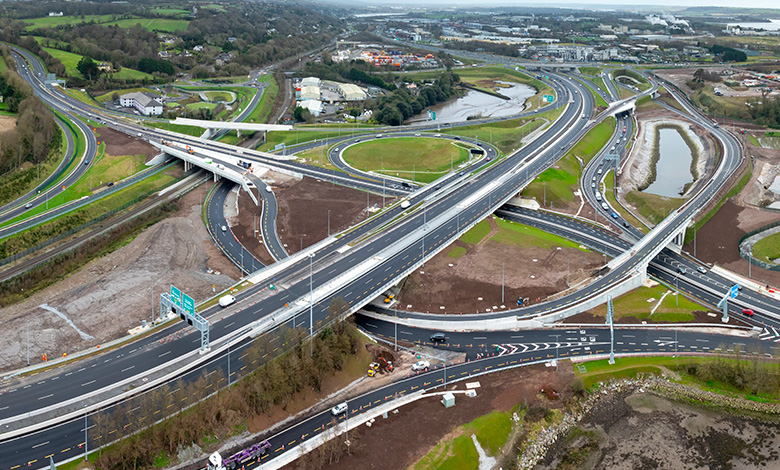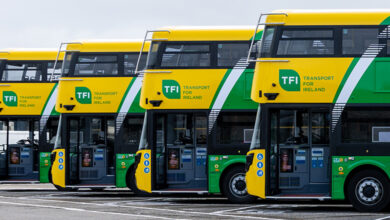Celebrating how the Dunkettle major junction reconfiguration in Cork improves capacity, safety, and travel times

Jacobs’ Project Manager Patrick de Feu managed the Works Monitoring team and technical advisory deliverables on this considerable project, which was delivered on budget and ahead of programme within challenging constraints including construction during the Covid-19 pandemic.
The new Dunkettle Interchange in Cork is a major junction reconfiguration to create a signal-free junction between the strategically important M8, N25 and N40 to the east of the city, reducing travel times and improving capacity and safety.
Transport Infrastructure Ireland (TII) aimed to significantly improve the existing junction layout for all users, including the junction safety, operation and capacity at this strategically important interface. Located in an intertidal area of conservation with important flora and fauna, all works had to be undertaken while maintaining full operation of the junction and the railway line running through the site.
Over 12 years, Jacobs has been TII’s trusted consultant to cover a range of complex challenges on the Dunkettle Interchange project. These have spanned a range of delivery phases, each with their own unique requirements.
Working in partnership with Cork County Council and Cork City Council to deliver the scheme, TII’s mission is to deliver transport infrastructure and services, which contribute to the quality of life for the people of Ireland and support the country’s economic growth.
“Jacobs’ involvement in this project has spanned over a decade, and it has allowed us to truly put our stamp on it. We have been given the opportunity to help create a major interchange that handles four key roads, sees up to 120,000 vehicles pass through it each day, and has removed all traffic signals on the main interactions, providing free flow movements and reducing travel times in the region.”
The challenge was complex: The volume of traffic and outdated junction configuration was severely impacting traffic into and out of Cork at the intersection of four key national routes. The importance of the interchange to regional traffic was equalled by the sensitivity of the surrounding flood plain and foreshore, sensitive interlinked intertidal ponds which manage daily sea level changes, and the Cork Harbour Special Protection Area which the site sits in. In addition, Jacobs supported in ensuring the site work could start and continue throughout the Covid-19 pandemic, with all associated on-site health and safety requirements.
The solution included a major reconfiguration of link upgrades and structures: This encompassed direct road links, a grade separated junction arrangement to the east of the existing Dunkettle Interchange, four new roundabouts, 52 structures of various forms, intelligent transport systems, pedestrian and cyclist facilities, and several culverts where the scheme crosses watercourses or intertidal areas.
From the very start of the early design, statutory consenting and regulatory body consultations, our approach has been full and open engagement with all stakeholders. This has built a project ecosystem which encourages direct communication, early engagement around risks, and an openness to challenge how best to deliver a project of this scale and complexity.
Acting as the employer’s representative on site, our strong client relationship enabled all project and business risks to be dealt with pragmatically. Similarly, we worked collaboratively with the contractor and their designer, always focusing on the key project objectives. Crucially, our site team invested in building a relationship with all local stakeholders and the wider users of the interchange in advance of and throughout construction. This communication and engagement focused on early sharing of works plans, timely traffic impact updates and being conscious of and managing the impact our scheme may have on the local population.
Our key technical challenges related to the complex intertidal drainage regime already in place, the challenge around the sensitivity of the current drainage and land layout to flooding, the difficult ground conditions our geotechnical team had to work with, and the structures team input to developing major interchange solutions in challenging ground. Our team developed and optimised a complex traffic model which considered the regional importance of this interchange. In addition, we ensured it could all be constructed safely while maintaining full junction operation with a live railway running through the site.
During the procurement process and subsequent construction monitoring and contract administration, this approach of open engagement and willingness to work as a larger team ensured the project completed on site ahead of schedule, which was an achievement in itself, given the working restrictions that Covid-19 placed on works throughout the construction.
Sustainability elements of the project were key: For example, over 2,400m3 of planings were taken from the runway at Cork Airport for reuse in temporary haul routes on site. Similarly, over 134,000m3 of earthworks fill were taken from local housing projects for reuse on site.
As key enablers and providers for transport infrastructure upgrades in the Cork region, we support a range of projects bringing industry-leading technical solutions and deep experience to help deliver outcomes that improve quality of life for communities, and support sustainability, social equity and the economy.






